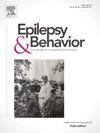婴儿期凝视行为与早发性癫痫患者两岁时的发育结果相关
IF 2.3
3区 医学
Q2 BEHAVIORAL SCIENCES
引用次数: 0
摘要
目的早发性癫痫患儿的神经发育结局差异很大,从典型发育到全面发育迟缓不等。婴儿时期形成的视觉技能对认知功能的发展至关重要。本观察性队列研究的目的是探讨早发性癫痫婴儿的凝视行为,并评估眼动追踪是否可以支持其神经发育的预测。方法对51例癫痫患儿(22例女性,平均癫痫发作年龄5岁,SD±2个月)进行反复眼动追踪和Hammersmith婴儿/新生儿神经学检查(HINE/HNNE)。两岁时的神经发育分为典型发育(Bayley [BSID-III]认知和语言或Griffiths [GMDS-III]量表平均得分≥85)和发育迟缓。在最初(3-10个月)和12个月的访问中,我们比较了发展组在非竞争性srt任务中注视的可靠性、凝视转移的概率和跳眼反应时间(srt)。凝视行为也在病因、综合征组和最佳与次优首次HINE/HNNE之间进行了比较。结果具有典型发育结局的婴儿(n = 23)在初始眼动追踪时的注视可靠性(p = 0.007)和注视转移概率(p = 0.012)均高于具有延迟结局的婴儿(n = 28)。在随访期间,srt变得更快,但在发育组之间没有显着差异。凝视行为与癫痫综合征、病因和初始HINE/HNNE结果相关。结论:早发性癫痫患儿在癫痫诊断后能否可靠地注视和转移视线与发育结局有关,这表明眼动追踪可能是一种有用的额外预后工具。本文章由计算机程序翻译,如有差异,请以英文原文为准。

Gaze behavior in infancy associates with developmental outcome at the age of two years in early-onset epilepsies
Purpose
The neurodevelopmental outcome of infants with early-onset epilepsies varies widely, ranging from typical development to global developmental delay. Visual skills, which emerge during infancy, are crucial for the development of cognitive functions. The aim of this observational cohort study was to explore gaze behavior in infants with early-onset epilepsy and evaluate if eye tracking could support prognostication of their neurodevelopment.
Methods
Fifty-one infants (22 females, mean seizure onset-age 5, SD ± 2, months) from a prospective epilepsy cohort underwent repeated eye tracking and Hammersmith Infantile/Neonatal Neurological examination (HINE/HNNE). Neurodevelopment at age two was categorized as typical development (mean Bayley [BSID-III] cognitive and language or Griffiths [GMDS-III] scales score ≥ 85) and developmental delay. At initial (age 3–10 months) and 12-month visit, we compared reliability of fixation, probability of gaze shifts and saccadic reaction times (SRTs) in a non-competitive SRT-task between developmental groups. Gaze behavior was also compared across etiologies, syndrome groups and between those with optimal versus suboptimal first HINE/HNNE.
Results
Infants with typical developmental outcome (n = 23) had higher reliability of fixation (p = 0.007) and higher probability of gaze shifts (p = 0.012) at initial eye tracking than those with delay (n = 28). SRTs became faster during the follow-up but did not differ significantly between the developmental groups. Gaze behavior associated with epilepsy syndrome, etiology, and initial HINE/HNNE result.
Conclusions
Ability to fixate reliably and shift gaze soon after the epilepsy diagnosis is associated with developmental outcome in infants with early-onset epilepsy, suggesting that eye tracking could be useful as an additional prognostic tool.
求助全文
通过发布文献求助,成功后即可免费获取论文全文。
去求助
来源期刊

Epilepsy & Behavior
医学-行为科学
CiteScore
5.40
自引率
15.40%
发文量
385
审稿时长
43 days
期刊介绍:
Epilepsy & Behavior is the fastest-growing international journal uniquely devoted to the rapid dissemination of the most current information available on the behavioral aspects of seizures and epilepsy.
Epilepsy & Behavior presents original peer-reviewed articles based on laboratory and clinical research. Topics are drawn from a variety of fields, including clinical neurology, neurosurgery, neuropsychiatry, neuropsychology, neurophysiology, neuropharmacology, and neuroimaging.
From September 2012 Epilepsy & Behavior stopped accepting Case Reports for publication in the journal. From this date authors who submit to Epilepsy & Behavior will be offered a transfer or asked to resubmit their Case Reports to its new sister journal, Epilepsy & Behavior Case Reports.
 求助内容:
求助内容: 应助结果提醒方式:
应助结果提醒方式:


